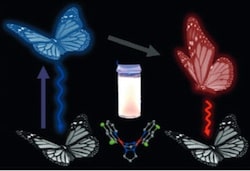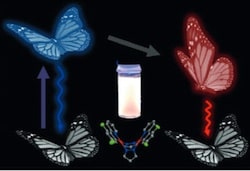
Speaking of improving energy supply and usage through improved precision in the control of matter, Kurzweil Accelerating Intelligence News reports a butterfly-shaped molecule that changes molecular structure upon photoexcitation, shortening the distance between two platinum atoms, producing both red and greenish-blue emission, resulting in white light production. From “‘Butterfly’ molecule could lead to new sensors, photoenergy conversion devices“:
A novel molecule that can take your temperature, emit white light, and convert photon energy directly to mechanical motions has been enhanced by Florida State University researchers.
Biwu Ma, associate professor in the Department of Chemical and Biomedical Engineering in the FAMU-FSU College of Engineering, created the molecular structure resembling a butterfly in a lab about a decade ago, but has continued to discover it has many other unique capabilities, described in the latest edition of the journal Angewandte Chemie [abstract].
And from a FAMU-FSU news release “‘Butterfly’ molecule could build sensors, photoenergy devices“:
For example, the molecular butterfly can flap its “wings” and emit both blue and red light simultaneously in certain environments. This dual emission means it can create white light from a single molecule, something that usually takes several luminescent molecules to achieve.
And, it is extremely sensitive to temperature, which makes it a thermometer, registering temperature change by emission color.
“This work is about basic, fundamental science, but also about how we can use these unique findings in our everyday lives,” Ma said.
Among other things, Ma and his team are looking at creating noninvasive thermometers that can take better temperature readings on infants, and nanothermometers for intracellular temperature mapping in biological systems. They are also trying to create molecular machines that are operated simply by sunlight.
This work presents both a novel molecular machine that could eventually find some use in more complex molecular machine systems, and a substance that could have near-term use as a sensor or a white light source. The better we understand how to control molecular motions, the more useful our toolkit will become for both near-term and advanced applications.
—James Lewis, PhD
